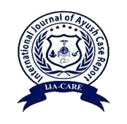An Ayurvedic and Modern Outlook on Vimlapana Upakrama (Gentle Massage) in Dushta Vrana - A Case Report
Abstract
Vrana which doesn’t heal in its natural course of healing time is said as Dushta Vrana. The fundamental causes of delayed healing are impaired tissue regeneration, angiogenesis, neurological issues along with Local and systemic disorders. Acharya Sushruta elaborately explains Shastirupakrama for the management of wounds aimed at effective healing. Shastirupakrama are broadly classified as Vrana Shodhana and Vrana Ropana. Vimlapana is the Upakrama advocated in the management of Vrana at the site of Shopha that may work by dispersing the accumulated Doshas in the corresponding Srotas so that Srotosangha may be released and pathology may break. The present study aims to understand the possible mechanism of Vimlapana Upakrama in the management of Vrana. Here we report a case of 69 year old male having a non-healing ulcer in the lateral aspect of bilateral legs since 6 months. The case was treated throughout with oral medication and Vimlapana Upakrama using Manjishtadi taila followed by daily dressings for 3 months. The ulcer was reduced by 50% in size as a result of this procedure, and normal skin pigmentation was also noted along with healthy granulation. Vimlapana Upakrama with Manjishtadi taila in this case resulted in enhanced wound healing in Dushta vrana.

This work is licensed under a Creative Commons Attribution-NonCommercial-NoDerivatives 4.0 International License.

